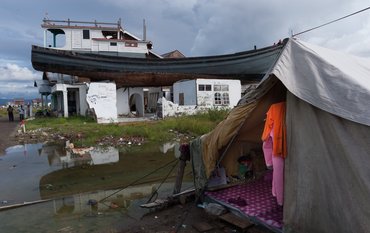Weaker and stronger lithospheric regions cause the rotation of the Victoria microplate, computer models suggest.
The East African Rift System (EARS) is a newly forming plate tectonic boundary at which the African continent is being separated into several plates. This is not a clean break. The system includes several rift arms and one or more smaller so-called microplates. According to GPS data, the Victoria microplate is moving in a counterclockwise rotation relative to Africa in contrast to the other plates involved.
Previous hypotheses suggested that this rotation is driven by the interaction of a mantle plume – an upward flow of hot rock within the Earth's mantle – with the microplate’s thick craton and the rift system. But now, researchers from the German Research Centre for Geosciences GFZ in Potsdam around Anne Glerum have found evidence that suggests that the configuration of weaker and stronger lithospheric regions predominantly controls the rotation of continental microplates and Victoria in particular. Their findings were published in the journal Nature Communications.
In the paper, the researchers argue that a particular configuration of mechanically weaker mobile belts and stronger lithospheric regions in the EARS leads to curved, overlapping rift branches that under extensional motion of the major tectonic plates induces a rotation. They used 3D numerical models on the scale of the whole EARS to compute the lithosphere and upper mantle dynamics of the last 10 million years.
“Such large models run on high performance computing clusters”, says Anne Glerum, main author of the study. “We tested the predictive strength of our models by comparing their predictions of velocity with GPS-derived data, and our stress predictions with the World Stress Map, a global compilation of information on the present-day crustal stress field maintained since 2009. This showed that the best fit was obtained with a model that incorporates the first order strength distributions of the EARS’ lithosphere like the one we prepared.”
There are many more continental microplates and fragments on Earth that are thought to rotate or have rotated. The lithosphere-driven mechanism of microplate rotation suggested in the new paper helps interpret these observed rotations and reconstruct plate tectonic motions throughout the history of the Earth.
Original study: Glerum, A., Brune, S., Stamps, D. S., Strecker, M., 2020. Victoria continental microplate dynamics controlled by the lithospheric strength distribution of the East African Rift. Nature Communications. DOI: 10.1038/s41467-020-16176-x
Scientific Contact:
Dr. Anne Glerum
GFZ Section Geodynamic Modelling
Helmholtz Centre Potsdam
GFZ German Research Centre for Geosciences
Tel.: +49 331 288-28766
E-mail: anne.glerum@gfz-potsdam.de
Media contact:
Dipl.-Phys. Philipp Hummel
Public and Media Relations
Helmholtz Centre Potsdam
GFZ German Research Centre for Geosciences
Telegrafenberg
14473 Potsdam
Tel.: +49 331 288-1049
E-Mail: philipp.hummel@gfz-potsdam.de
Twitter: twitter.com/GFZ_Potsdam












![[Translate to English:] [Translate to English:] Abror Gafurov von dem Schriftzug "Welcome to Azerbaijan" und den UN und COP Logos](/fileadmin/_processed_/2/5/csm_2024_11_Baku_COP29_Abror_Gafurov_1042faec82.jpeg)


![[Translate to English:] Martin Herold standing in front of the library on the Telegrafenberg](/fileadmin/_processed_/c/d/csm_Martin_Herold_d385ee4dd9.jpeg)
![[Translate to English:] Many people are listening to a presentation in the GFZ lecture hall.](/fileadmin/_processed_/c/a/csm_1_Bild1_hell_b9c0e9f5ed.jpeg)






![[Translate to English:] Both scientists sitting on stools in front of a wall of books in the Telegrafenberg library](/fileadmin/_processed_/6/6/csm_Buiter_Castell_DORA_4_e87cb1ea18.jpeg)
![[Translate to English:] Gruppenbild mit 4 Personen](/fileadmin/_processed_/8/d/csm_20241017_GFZ-Emmerman-Medal-005_web_reinhardtundsommer_21a414fa4a.jpeg)






![[Translate to English:] Ice landscape with five red tents](/fileadmin/_processed_/8/9/csm_Zeltlager_auf_dem_Eis_Urheberin_Jenine_McCutcheon_5ced2d523b.jpeg)

